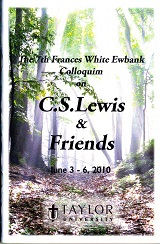Event Title
Academic Paper Session II-B
Location
Rupp 205
Start Date
4-6-2010 10:30 AM
Description
"Dream Cities and Cardboard Worlds: Sayers's Moral Vision in Murder Must Advertise" - Frances Fowler-Collins
Murder Must Advertise represents a turning point in Dorothy L. Sayers’s development as a writer and Christian thinker. Previously, she had depicted sinful individuals, but here she expands her moral vision to encompass social sin on a grand scale, focusing on advertising. The novel’s major structural device is the comparison of two groups: an advertising agency and a drug trafficking ring. Although these groups differ superficially, Sayers suggests they are fundamentally similar, as each is a “dream city” based on an illusion. They resemble each other in three ways. In both, a small group of people operates behind the scenes to exploit a larger group in order to profit financially. Both are relentlessly materialistic. And both deny death even though they are agents of death, either physical or spiritual. Although Murder Must Advertise is artistically flawed, it lays the foundation for Sayers’s later work in social criticism and Dante commentary.
"Charles Williams and the Quest for the Holy Grail" - Susan Wendling
Charles Williams (1886-1945) devoted his life to “the Matter of Britain,” seen in a private scrapbook, his novels and Arthurian poetry, and his prose analysis, The Figure of Arthur. Exploring two myths, King Arthur and the Grail Quest, Williams creatively combined them. Reasons are given why Williams was so intrigued with the Grail legends: the failure of earlier sources to develop the “never quite fulfilled hints of profound meaning”; the desire as a poet to discover images to convey his themes of romantic theology as well as the probing of the nature of co-inherence with its “doctrines” of Exchange and Substituted Love; the identification of Williams with Taliessin, King Arthur’s poet, the central figure in his own poetry; and finally, the High Prince Galahad, who achieves the Vision of the Grail, but whose mysterious begetting fascinates Williams with its paradoxes and spiritual “contradictions” presented in the old tales.
Event Type
Paper
Academic Paper Session II-B
Rupp 205
"Dream Cities and Cardboard Worlds: Sayers's Moral Vision in Murder Must Advertise" - Frances Fowler-Collins
Murder Must Advertise represents a turning point in Dorothy L. Sayers’s development as a writer and Christian thinker. Previously, she had depicted sinful individuals, but here she expands her moral vision to encompass social sin on a grand scale, focusing on advertising. The novel’s major structural device is the comparison of two groups: an advertising agency and a drug trafficking ring. Although these groups differ superficially, Sayers suggests they are fundamentally similar, as each is a “dream city” based on an illusion. They resemble each other in three ways. In both, a small group of people operates behind the scenes to exploit a larger group in order to profit financially. Both are relentlessly materialistic. And both deny death even though they are agents of death, either physical or spiritual. Although Murder Must Advertise is artistically flawed, it lays the foundation for Sayers’s later work in social criticism and Dante commentary.
"Charles Williams and the Quest for the Holy Grail" - Susan Wendling
Charles Williams (1886-1945) devoted his life to “the Matter of Britain,” seen in a private scrapbook, his novels and Arthurian poetry, and his prose analysis, The Figure of Arthur. Exploring two myths, King Arthur and the Grail Quest, Williams creatively combined them. Reasons are given why Williams was so intrigued with the Grail legends: the failure of earlier sources to develop the “never quite fulfilled hints of profound meaning”; the desire as a poet to discover images to convey his themes of romantic theology as well as the probing of the nature of co-inherence with its “doctrines” of Exchange and Substituted Love; the identification of Williams with Taliessin, King Arthur’s poet, the central figure in his own poetry; and finally, the High Prince Galahad, who achieves the Vision of the Grail, but whose mysterious begetting fascinates Williams with its paradoxes and spiritual “contradictions” presented in the old tales.


